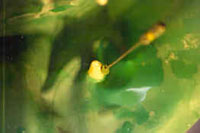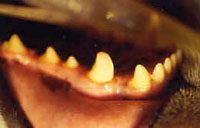

Anesthesia | Periodontal Disease | Extractions
Endodontics | Orthodontics | Neoplasia
Trauma | Dysphagia | The Feline Oral Cavity
|
Endodontics Root canal therapy is a great option to treat animals with "pulp" disease. Typically the pet breaks off the crown of an upper fourth premolar or a canine tooth exposing the pulp ("nerve") on the inside. Not only is this painful, but it always leads to an abscessed tooth. Again, the problem is that most animals mask the pain until so much damage is done that nothing can be done to salvage the tooth. Early treatment is the best answer. Waiting until the tooth turns black is the wrong answer. The indication for root canal therapy is pulpal disease. Pulpal disease is caused by:
The procedure consists of placing the pet under general anesthesia as discussed earlier. The goals of endodontic therapy are to:
 Root Canal File in Tooth While most veterinary dentists agree on the technique, major discussions occur on the various agents used in each step. The author prefers to irrigate the canal system with 1/2 strength (from the bottle) bleach, full strength hydrogen peroxide, and rinse with saline. The endodontic system is irrigated with each agent in an individual syringe with a 1-1/2 inch 22 or 25 gauge needle. Care is used when expressing these liquids into the canal so chances of extra apical infusion is minimized. Drying is accomplished using appropriate length paper points. Old pulp exposures with necrotic or absent pulp will have little if any bleeding. Fresh pulp exposures with vital or "sick" pulp may seep blood through the apex following drying. A single spot of blood on a paper point is acceptable. More than 1/2 mm apical bleeding on a paper point is not acceptable. Apical bleeding occurs from either apical perforation or inadequate pulp removal. Apical perforation is determined by rechecking working lengths of the endodontic file with x-rays. Incomplete pulp removal is determined when bleeding continues and endodontic file length is correct. If perforation has occurred, a "step back" technique is used to create a seat for a larger gutta percha point. If incomplete pulp removal is determined, reinstrumentation is performed until bleeding stops. On some occasions this can be time consuming. These are the common problems encountered in endodontic therapy. It is beyond the scope of this site to list all endodontic complications and their treatments. Perhaps the single greatest debate among veterinary endodontists is the choice of filling materials. Traditionally, zinc oxide and eugenol (ZOE) has been used in combination with gutta percha points. Recently, calcium hydroxide products have gained favor with glass ionomer products the newest "kid on the block". It matters more that the correct technique is used assuring an apical fill and less which material is used. Attention to detail is the hallmark for successful endodontic therapy. Currently the author favors a calcium hydroxide product (SealApex-Kerr) and conventional gutta percha points where feasible for most procedures. Gutta percha is available both in conventional points and in heated preparations. It is best for the entry level veterinarian to master placement of standard gutta percha points before attempting to use a heated product. Heated products, regardless of manufacture, are technique sensitive and not forgiving when mistakes are made. Once standard techniques are mastered, Ultrafil, Thermafil, Successfil, or Touch and Heat systems are suitable for veterinary endodontics. Another warning to the training veterinary endodontist is to learn how to use hedstrom and k-files. Hedstrom files are strictly push-pull files and if rotated may (usually!) become stuck and disarticulate (previously "separation" or "broken"). K-files are very forgiving rotational instruments and tend not to break. Instrument breakage may require surgical endodontics to retrieve the broken end. Obviously it is better to avoid this complication by obeying the rules. Once the endodontic procedure is finished, crown restoration is the final step. Again, the specific products and techniques used are a personal preference and dictated by each situation. The goal is to maintain function and preserve esthetics. It is beyond the scope of this site to cover every situation. However, in general the newer hybrid composites are used on non occlusal surfaces where loading is at a minimum. Because composites have poor resistance to shear forces it is best to avoid significant crown build ups that the animal will simply break off. The composites do have improved resistance to compressive forces and thus can be used in the anterior mouth in access holes and coronal fracture sites, whereas full metal crowns are used in high stress areas and in animals who are abusive to their teeth. Kerr's Optibond System or Den Mats Tenure System are good choices for dentin bonding systems. Any hybrid composite will work in the mouth provided the manufacturer's directions are observed. Clearly, light cure systems are the systems of choice. Chemical cure systems simply take too long to complete.  Restored Canine Tooth (with Composite) Full crown restorations are accomplished in five steps:
Finally, the MOST important part of endodontic therapy is radiology. The standard in veterinary dentistry is to radiograph the tooth multiple times during the procedure. Without radiography it is impossible to determine if an apical fill is accomplished. The more compulsive the veterinarian is in documenting with x-rays, the higher the success rate the animals will enjoy. Once the root canal procedure is finished, the tooth crown is restored to a functional state. The restorative materials range from plastics (composite resins) to metals (amalgams, cast crowns). The type of material used depends on the tooth and the type of animal. Very aggressive chewers will need rugged restorations such as cast metal crowns while laid back animals may need only composite restorations. In any event the veterinary dentist will determine what is needed for the pet. The bottom line is that ignoring the tooth is not an option. Back to Main Treatments and Procedures Page Return to Top of Page |